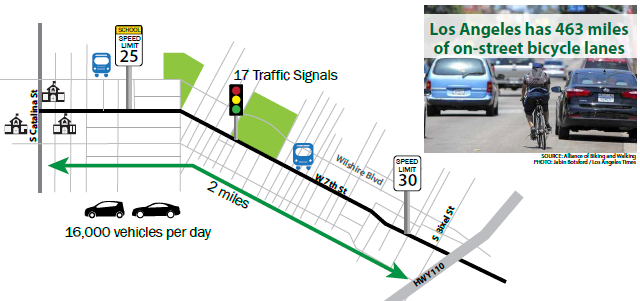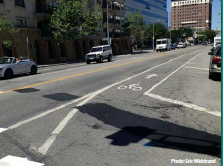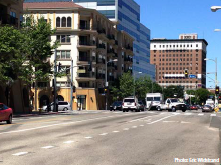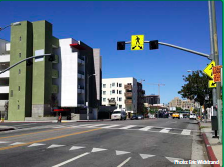ROAD DIET: KEY INGREDIENT IN LOS ANGELES' BICYCLE MASTER PLAN
| Objective | Features | Results |
|---|---|---|
|
|
|


BACKGROUND
In 2011, the Los Angeles Department of Transportation (LADOT) completed a Road Diet on Seventh Street in order to install bicycle lanes along this east-west arterial just west of downtown Los Angeles from Bixel Street to Catalina Street. With traffic volumes of approximately 16,000 vehicles per day and a high number of pedestrians and bicyclists, this corridor is busy with several transportation modes.
This 2-mile stretch of Seventh Street contains 17 traffic signals and serves numerous metro bus routes. The land use is mainly multi-family residential and commercial, with several large parks along the corridor. A high school is located on the west end, and there are two middle schools nearby. The speed limit for the roadway is 30 mph except in areas where there are 25 mph school speed zones.
The City of Los Angeles developed a Bicycle Master Plan that provides direction for improving bicycle mobility and encouraging more bicycle ridership by expanding the existing bikeway network and improving connectivity. As a result of this Bicycle Master Plan, the installation of bicycle lanes is a major driving force for Road Diets in Los Angeles, but the overarching goal for the conversions is safety.
 7th Street looking west at Bixel Avenue |
 7th Street looking west at Bixel Avenue |
 7th Street looking west at Coronado |
OUTREACH
Prior to the implementation of the Road Diet, LADOT prepared a presentation that discussed expected benefits to safety, traffic calming, non-motorized accessibility, business access, and community health. LADOT discovered that emphasizing the safety benefits of Road Diets is important in gaining public acceptance.
Each corridor is unique, and LADOT found that working with their city council was essential to beginning a successful outreach process. The Los Angeles County Bicycle Coalition and other bicycle activists and community leaders strongly supported the project and assisted in the community outreach.1
RESULTS
After the completion of the Seventh Street Road Diet, LADOT received positive feedback from users, and a before-and-after bicycle count conducted by the Los Angeles County Bicycle Coalition showed that bicycle use in the corridor tripled once the Road Diet and new bicycle lanes were completed. LADOT also conducted some traffic analyses at several key intersections along the corridor and found that the results were satisfactory.
1Joe Linton, "Seventh Street Bike Lanes Installed," CICLAVIA, August 15, 2011. Accessed March 17, 2015. Available at: https://ciclavia.wordpress.com/2011/08/15/seventh-street-bike-lanes-installed/
